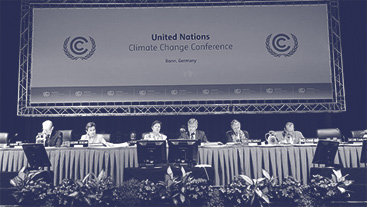New analysis finds that emissions pledges ahead of UN climate summit are not ambitious enough to avoid dangerous climate change

A more up to date analysis of INDCs submitted (published in October 2015) is available to download here.
The pledges to reduce greenhouse gas emissions that have been made so far by countries ahead of a crucial climate change summit are not sufficient to avoid dangerous global warming of more than 2 centigrade degrees, according to an analysis published today (19 August 2015) by the Grantham Research Institute on Climate Change and the Environment and the ESRC Centre for Climate Change Economics and Policy at London School of Economics and Political Science.
A paper describing the analysis concludes that the intended national determined contributions, or INDCs, that had been submitted by 20 July 2015 by 46 countries to the secretariat of the United Nations Framework Convention on Climate Change, would lead to annual global emissions in 2030 of 56.9 to 59.1 billion tonnes of carbon dioxide equivalent.
While this total is much less than a ‘business as usual’ pathway that would mean emissions reach 68 billion tonnes of carbon dioxide equivalent by 2030, it is much higher than the 36 billion tonnes that the United Nations Environment Programme has indicated would be consistent with having a 50 to 66 per cent chance of avoiding a rise in global average temperature of more than 2 centigrade degrees above its pre-industrial level.
The pledges also fall well short of the target of 42 billion tonnes for a pathway that avoids the temperature limit by using technologies that create ‘negative emissions’, such as bioenergy with carbon capture and storage (BECCS).
The authors of the paper – Rodney Boyd, Joe Cranston Turner and Bob Ward – conclude that “while there has been progress compared with a ‘business as usual’ global emissions pathway, there is a gap between the emissions pathway that would result from current ambitions and plans, including those goals outlined by the submitted INDCs, and a pathway that is consistent with a reasonable chance of limiting the rise in global average temperature to no more than 2°C above pre-industrial levels”.
The authors call for “hard work over the next few months by all countries to find credible ways of achieving bigger emissions reductions which can be included in INDCs to be submitted to the UNFCCC secretariat, and/or achieved through additional efforts by partnerships”.
They also highlight a need for “the creation of a mechanism, to be included in the agreement emerging from COP21 in Paris in December 2015, for countries to review their efforts and to find ways of ramping up the ambition of their emissions reductions by 2030 and beyond”.
NOTES FOR EDITORS
- The Grantham Research Institute on Climate Change and the Environment (https://www.lse.ac.uk/grantham) was launched at the London School of Economics and Political Science in October 2008. It is funded by The Grantham Foundation for the Protection of the Environment (https://www.granthamfoundation.org/).
- The ESRC Centre for Climate Change Economics and Policy (https://www.cccep.ac.uk) is hosted by the University of Leeds and the London School of Economics and Political Science. It is funded by the UK Economic and Social Research Council (https://www.esrc.ac.uk/). The Centre’s mission is to advance public and private action on climate change through rigorous, innovative research.
A more up to date analysis of INDCs submitted (published in October 2015) is available to download here.

